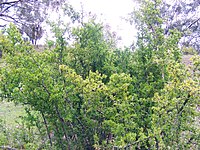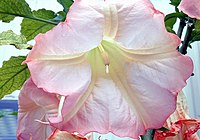
Fruit ripening in Lycium barbarum and Lycium ruthenicum is associated with distinct gene expression patterns
Sign Up to like & getrecommendations! Published in 2020 at "FEBS Open Bio"
DOI: 10.1002/2211-5463.12910
Abstract: Goji berries have been used as food and medicine for millennia. Due to their high morphological similarity, fruits of two distinct species belonging to the family Solanaceae, Lycium barbarum (LB) and Lycium chinense (Chinese boxthorn),… read more here.
Keywords: lycium; fruit; lycium ruthenicum; expression ... See more keywords

Effects of 2,4-dichlorophenoxyacetic acid on the expression of NLRP3 inflammasome and autophagy-related proteins as well as the protective effect of Lycium barbarum polysaccharide in neonatal rats.
Sign Up to like & getrecommendations! Published in 2021 at "Environmental toxicology"
DOI: 10.1002/tox.23358
Abstract: The pesticide 2,4-dichlorophenoxyacetic acid (2,4-D) has neurotoxic effects, but its mechanism is not clear. In this study, a 2,4-D (75 mg/kg. b.w) exposure model was established in SD rats with colostrum. Lipopolysaccharide (1 mg/kg b.w) was used… read more here.
Keywords: effect; barbarum polysaccharide; nlrp3 inflammasome; lycium barbarum ... See more keywords

Mechanism of 2,4‐Dichlorophenoxyacetic acid‐induced damage to rat testis via Fas/FasL pathway and the protective effect of Lycium barbarum polysaccharides
Sign Up to like & getrecommendations! Published in 2022 at "Environmental Toxicology"
DOI: 10.1002/tox.23635
Abstract: The herbicide 2,4‐Dichlorophenoxyacetic acid (2,4‐D) is widely used to control broadleaved weeds and has been associated with male infertility. We studied the molecular mechanisms of 2,4‐D induced male reproductive system damage and the protective effects… read more here.
Keywords: dichlorophenoxyacetic acid; lycium barbarum; fas fasl; barbarum polysaccharides ... See more keywords

Protective effect of Lycium barbarum polysaccharide on di-(2-ethylhexyl) phthalate-induced toxicity in rat liver
Sign Up to like & getrecommendations! Published in 2021 at "Environmental Science and Pollution Research"
DOI: 10.1007/s11356-020-11990-8
Abstract: Di-(2-ethylhexyl)-phthalate (DEHP) is the most commonly used plasticizer and it has been a ubiquitous environmental contaminant which affects health. The purpose of this study was to investigate the protective effect of the Lycium barbarum polysaccharide… read more here.
Keywords: toxicity rat; protective effect; barbarum polysaccharide; ethylhexyl phthalate ... See more keywords

Mechanism of Lycium barbarum polysaccharides liposomes on activating murine dendritic cells.
Sign Up to like & getrecommendations! Published in 2019 at "Carbohydrate polymers"
DOI: 10.1016/j.carbpol.2018.10.057
Abstract: Dendritic cells (DCs) are professional antigen-presenting cells (APC) that play a central role in the initiation and regulation of immune responses. We have previously demonstrated that Lycium barbarum polysaccharides liposomes (LBPL) as immune adjuvant elicits… read more here.
Keywords: barbarum polysaccharides; lycium barbarum; polysaccharides liposomes; dendritic cells ... See more keywords

Lycium barbarum polysaccharides: Extraction, purification, structural characterisation and evidence about hypoglycaemic and hypolipidaemic effects. A review.
Sign Up to like & getrecommendations! Published in 2018 at "Food chemistry"
DOI: 10.1016/j.foodchem.2018.01.176
Abstract: In the last decades, glycoconjugates from Lycium barbarum L. fruit (Goji berry) have received a great attention for their potential health-promoting effects. The present review includes a survey of extraction and purification methods of these… read more here.
Keywords: extraction purification; barbarum polysaccharides; structural characterisation; hypoglycaemic hypolipidaemic ... See more keywords

Lycium barbarum polysaccharide attenuates myocardial injury in high-fat diet-fed mice through manipulating the gut microbiome and fecal metabolome.
Sign Up to like & getrecommendations! Published in 2020 at "Food research international"
DOI: 10.1016/j.foodres.2020.109778
Abstract: High-fat diets (HFDs) can induce health problems including gut microbiota dysbiosis and cardiac dysfunction. In this study, we modulated the gut microbiota in mice to investigate whether Lycium barbarum polysaccharide (LBP), a potential prebiotic fiber,… read more here.
Keywords: myocardial injury; high fat; mice; barbarum polysaccharide ... See more keywords

Lycium barbarum polysaccharide alleviates nonylphenol exposure induced testicular injury in juvenile zebrafish.
Sign Up to like & getrecommendations! Published in 2017 at "International journal of biological macromolecules"
DOI: 10.1016/j.ijbiomac.2017.06.035
Abstract: Nonylphenol is an endocrine disrupting chemicals that can disrupt the organisms' reproductive system, and exists widely in rivers and lakes. Lycium barbarum polysaccharide (LBP) is the main active constituent (about 10%) in Lycium barbarum, which… read more here.
Keywords: barbarum polysaccharide; lycium barbarum; nonylphenol exposure; testicular injury ... See more keywords

Fungal chitosan and Lycium barbarum extract as anti-Listeria and quality preservatives in minced catfish.
Sign Up to like & getrecommendations! Published in 2017 at "International journal of biological macromolecules"
DOI: 10.1016/j.ijbiomac.2017.06.097
Abstract: Listeria monocytogenes is a foodborne bacterial pathogen that causes serious health risks. Chitosan (Ch) is a bioactive polymer that could be effectively applied for foodstuffs biopreservation. Lycium barbarum (Goji berry) is ethnopharmaceutical fruit that have… read more here.
Keywords: quality; lycium barbarum; barbarum; barbarum extract ... See more keywords

Synthesis, stability and anti-fatigue activity of selenium nanoparticles stabilized by Lycium barbarum polysaccharides.
Sign Up to like & getrecommendations! Published in 2021 at "International journal of biological macromolecules"
DOI: 10.1016/j.ijbiomac.2021.03.018
Abstract: Lycium barbarum polysaccharides (LBP) with different molecular weights (LBP1, LBP2 and LBP3) of 92,441 Da, 7714 Da, and 3188 Da were used as stabilizers and capping agents to prepare uniformly dispersed selenium nanoparticles (SeNPs), and determined the storage… read more here.
Keywords: lycium barbarum; stability; lbp1 senps; anti fatigue ... See more keywords

A homogeneous polysaccharide from Lycium barbarum: Structural characterizations, anti-obesity effects and impacts on gut microbiota.
Sign Up to like & getrecommendations! Published in 2021 at "International journal of biological macromolecules"
DOI: 10.1016/j.ijbiomac.2021.05.209
Abstract: Lycium barbarum polysaccharides (LBPs) are known for their beneficial effects on diabetes, NAFLD and related chronic metabolic diseases induced by high-fat diet (HFD). However, the relevant researches are mainly about the whole crude polysaccharides, the… read more here.
Keywords: homogeneous polysaccharide; gut microbiota; obesity; lycium barbarum ... See more keywords